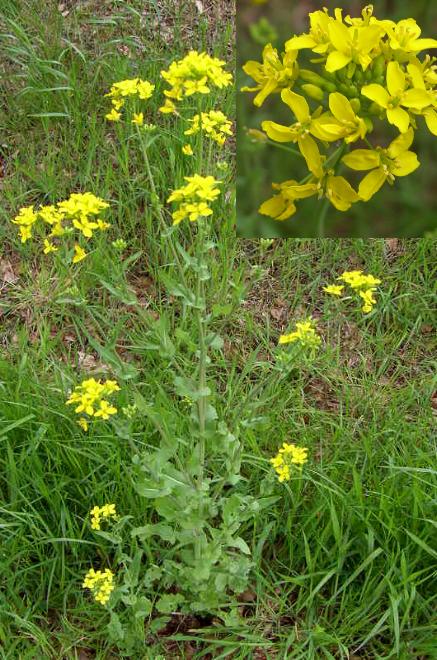Oilseed RapeScientific Name: Brassica napus |
Rape is not a native plant and was brought to the British Isles in Roman times. The present plant is 'man-made' in that it has been domesticated by breeding. It is an annual or biennial which has become naturalised throughout the countryside popping up along country roads and sometimes in gardens. As a member of the Brassicaceae, the leaves can also be used as a potherb. The oil has been used with camphor to massage stiff joints.
It is grown as a commercial crop mainly for the oil which is extracted from the seeds. After harvesting the seeds are pressed to release the oil and the remaining pulp is used as a high-protein feed cake for cattle, pigs and chickens. Rapeseed oil is widely used in the food industry and in soap manufacture. Rich in polyunsaturated fats and Omega-3, it is better consumed in the cold state rather than for cooking.
It is attacked by Flea Beetles which damage the leaves and eat the developing seeds. This can greatly reduce the crop and it is becoming uneconomic to grow it in the UK where the neonicotinoid pesticides that combat the beetle were banned in 2018 due to their effect on pollinating nsects.
It can be processed into Biodeisel as a relatively more environmentally friendly fuel since it does not add to the Carbon load - ie. the carbon dioxide released when it is burnt was recently taken from the atmosphere and not millions of years ago as with fossil fuels, so it is carbon-neutral.
Because of the importance to industry, Rape has been the subject of Genetic Modification to produce a cultivar called Roundup Ready which is resistant to the herbicide Roundup, by the Monsanto Company.
The leaves are grey-green and the young plants may be mistaken for Opium Poppies, Papaver somniferum if they appear in the garden. The basal leaves have an uneven edge, the upper leaves have smoother edges, do not have a stalk and wrap around the stem. They can be picked and cooked as a spinach
The yellow flowers appear in late spring and have four petals, typical of all the members of this Family. They are pollinated mainly by bees, but have been implicated as being an allergen to asthmatics, probably due to the large quantities of pollen which may be present close to arable production.
The plants are easily uprooted and the taproot usually comes away intact so it is unlikely that a Weedkiller would be required in the garden situation. The Glyphosate-resistant GM cultivar has not been introduced for arable production in Europe.
Follow these links for further details on Weeds, Weed Removal and Weed Prevention.
